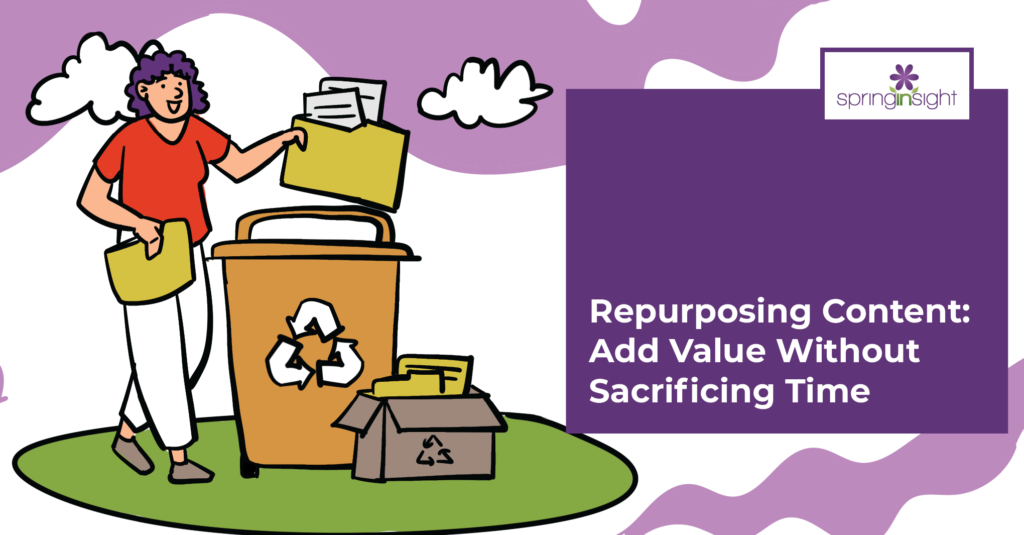
Repurposing Content: Add Value Without Sacrificing Time
If you’re a business owner, you know how draining it can be to create new content constantly. We’ve been thinking the same thing here at Spring Insight – so we recently decided to reevaluate our content strategy. And since we’re in the business of making your business successful, we’re walking you through exactly how we did it.
When you’re creating high-quality content, there are a few things you should aim to accomplish:
- Add value
- Stay consistent
- Be able to reuse and recycle
And as much as we love Mother Earth, we’re not talking about recycling papers and plastics. We’re talking about content.
This month, we’ll cover everything from the basics of repurposing content to how exactly to put it into action and make this strategy work for you. And, yes, the article you’re reading now is part of our own content repurposing strategy. Pretty meta, right?
What is Content Repurposing?
Repurposing content is taking an already-developed piece of content and using that information to create something new. It’s a great way to take a topic you have in-depth knowledge of and stretch that information across various channels and mediums. And if you plan, you can create content that’s already ripe and ready for repurposing.
For example, if you create a YouTube video covering something related to your business, you can then write a search-engine optimized blog post with the same information. That blog content can also be upcycled into social media posts, infographics, email newsletters, or anything else to connect you to your audience. No additional research is needed.
What Are the Benefits of Repurposing Content?
You may be asking us (not out loud, hopefully), “Why repurpose content if the information is already out there?” We’re so glad you asked.
Converting your content into other mediums lets you capitalize on already popular content to reach a new audience. If you have content that’s performing well, why not milk it? For example, maybe your newest customer wants to learn more about a product or service you offer, but they don’t respond well to videos. You can easily convert your video content into a blog or social media post to deliver that information.
Our Approach to Repurposing Content
As we mentioned, our Spring Insight team has recently implemented a content repurposing strategy, and there are only a few steps to begin:
-
Set a Theme
Theme months are truly the backbone of our strategy. We tend to stick to one big topic per month, and all of our content is built around it. As a result, we can build a full marketing campaign for the month off one overarching topic.
You’ll notice that this month we’re covering content repurposing (welcome to the intro to the series, by the way). But we’ll discuss more on theme months in our next post. (Yes, a blog on theme months is, indeed, part of our theme month.)
2. Generate Ideas
Once you have your theme set, come up with a list of topics that can function as part of the series but still do well independently. Evergreen content is best, but seasonal or time-sensitive subjects can still work great.
Try to answer questions your target audience may have in your area of expertise or break down a complex process in ways your readers can understand. A content grid can help you branch out on topics while staying within your theme. If you’re looking for even more topic inspiration, we’ve got you covered.
3. Make a Plan
Planning is the key to staying consistent and ensuring your content is repurposable. If you go into every blog post with a blank page and a dream, it’s easy to run out of ideas or fall into an irregular posting schedule.
Once you have a healthy number of big-picture themes and deep-dive topics, create a content calendar and stick to it. And remember that the brainstorming session is never over – good content strategies are always ongoing.
4. Create the Content
Even once you have your exact topics chosen for the month, creating the content itself is sometimes the most challenging step. In addition to creating high-quality content that will provide value to your audience, you’ll also want to ensure it’s optimized for search engines and can easily be repurposed.
Or you can work with our expert writers to create content that checks all of your boxes. Your call.
So… Is Your Content Repurposing Strategy Working?
Well, you’re reading this, aren’t you?
Because of our successful repurposing strategy, we can pitch and create content that fits our target audiences. Before implementing this strategy, we were barely producing content and were not on a consistent schedule. But now, our ideas are generated so far in advance that we always have at least six months of content planned and can write it all on time.
As promised, next week, we’ll be delving more into the specifics of theme months and how we use them to create recyclable content. But in the meantime, you can contact our team to learn how content repurposing can work for you.
